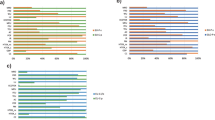Abstract
Purpose
This paper explores a computational method to resolve some of the problems of external normalization in the life cycle impact assessment (LCIA) process of midpoint characterized impacts. Problems inherent to external normalization (per capita per year for a defined region) that reduce the ability to accurately calculate the most significant impact categories include
-
a)
Bias created by a range of measurement disparities
-
b)
Inverse proportion of the scale of the reference system impacts to the normalized product system impacts
-
c)
Measurement and methodological uncertainties
Methods
This paper demonstrates a method called Process Inventory Dataset (PID) normalization. PID normalization modifies the normalized impact value by a normalizing factor which puts a probability distribution on average normalized impact categories for an entire process inventory dataset.
Results
PID normalization allows for significant variation of normalized impact ratio impact values among impact categories and among materials and processes. PID normalization works with incomplete process inventory and normalization data to deliver normalized impact ratio values that more accurately identify the impact categories with the most significant impacts in the LCIA process.
Conclusions
Although PID normalization does not eliminate all of the bias that can occur from midpoint characterization and external normalization and may not reduce all uncertainties, it substantially trims the effects of normalization bias and eliminates inverse proportionality within one normalization dataset. It allows for a more accurate interpretation of normalized and weighted life cycle assessment results.










Similar content being viewed by others
References
Bare J, Gloria T (2006) Critical analysis of the mathematical relationships and comprehensiveness of life cycle impact assessment approaches. Environ Sci Technol 40:1104–1113
Bare J, Gloria T, Norris G (2006) Development of the method and U.S. normalization database for life cycle impact assessment and sustainability metrics. Environ Sci Technol 40:5108–5115
Bare J, Hofstetter P, David W, Helias A, Udo de Haes H (2000) Midpoints versus endpoints: the sacrifices and benefits. Int J Life Cycle Assess 5(6):319–326
Bare J, Norris G, Pennington D, McKone T (2003) The tool for the reduction and assessment of chemical and other environmental impacts. J Ind Ecol 6:3–4
Bishop C (2006) Pattern recognition and machine learning. Springer, New York
Ciroth A (2009) Mathematical analysis of the ecoinvent database with the purpose of developing new validation tools. Life Cycle Assessment IX Conference http://lcacenter.org/LCA9/sessions/Databases.html. Accessed Oct 2009
Feller W (1968) An introduction to probability theory and its applications. Wiley, New York
Finnveden G (1996) Valuation methods within the framework of life cycle assessment. Swedish Environmental Research Institute, Stockholm
Finnveden G, Eldh P, Johansson J (2006) Weighting in LCA based on ecotaxes, development of a mid-point method and experiences from case studies. Int J Life Cycle Assess 11(1):81–88
Finnveden G, Hauschild M, Ekvall T, Guinée J, Heijungs R, Hellweg S, Koehler A, Pennington D, Suh S (2007) Recent developments in life cycle assessment. J Environ Manage 91:1–21
Friely N, Pettitt N, Reeves R, Wit E (2003) Bayesian inference in hidden Markov random fields for binary data defined on large lattices. J R Stat Soc 65(1):236–246
Gloria T, Lippiatt B, Cooper J (2007) Life cycle impact assessment weights to support environmentally preferable purchasing in the United States. Environ Sci Technol 41(21):7551–7557
Guinée J, Gorrée M, Heijungs R, Huppes G, Kleijn R, Wegener Sleeswijk A, Udo de Haes HA, de Bruijn J, van Duin R, Huijbregts M (2002) Handbook on life cycle assessment: operational guide to the ISO standards. Kluwer Academic Publishers, Dordrecht
Heijungs R, Guinée J, Klijn R, Rovers V (2007) Bias in normalisation: causes, consequences, detection and remedies. Int J Life Cycle Assess 12(4):211–216
Institute of Environmental Sciences (2002) Handbook on impact categories, CML 2001, Leiden University
International Organization for Standardization (2006) ISO 14044. Environmental management—life cycle assessment—requirements and guidelines, Geneva
Lee H (2002) Difficulties in estimating the normalizing constant of the posterior for a neural network. J Comput Graph Stat 11:222–235
Lippiatt B (2007) Building for environmental and economic sustainability technical manual and user guide 4.0. National Institute of Standards and Technology, Gaithersburg
Norris G (2001) The requirement for congruence in normalization. Int J Life Cycle Assess 6(2):85–88
Reap J, Roman F, Duncan S, Bras B (2008) A survey of unresolved problems in life cycle assessment. Part 2: impact assessment and interpretation. Int J Life Cycle Assess 13:374–388
Seppäla J, Hämäläinen R (2001) On the meaning of the distance-to-target weighting method and normalisation in life cycle impact assessment. Int J Life Cycle Assess 6(4):211–218
Soares S, Toffoletto L, Dechênes L (2006) Development of weighting factors in the context of LCIA. J Cleaner Prod 14:649–660
Author information
Authors and Affiliations
Corresponding author
Additional information
Responsible editor: Michael Hauschild
Appendix
Appendix
Rights and permissions
About this article
Cite this article
White, P., Carty, M. Reducing bias through process inventory dataset normalization. Int J Life Cycle Assess 15, 994–1013 (2010). https://doi.org/10.1007/s11367-010-0215-0
Received:
Accepted:
Published:
Issue Date:
DOI: https://doi.org/10.1007/s11367-010-0215-0




